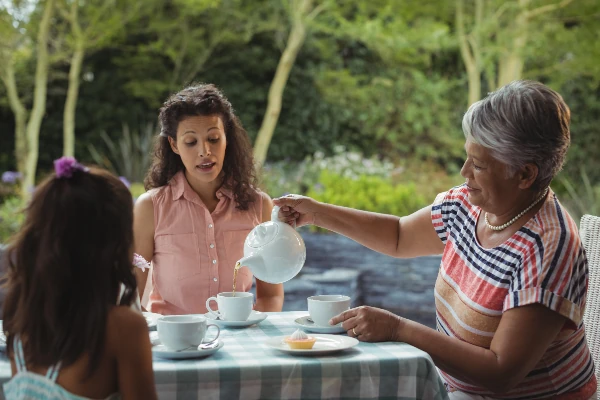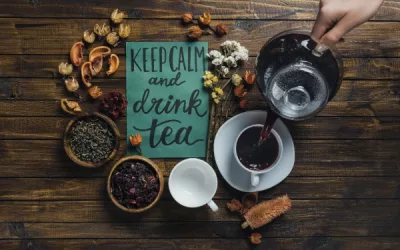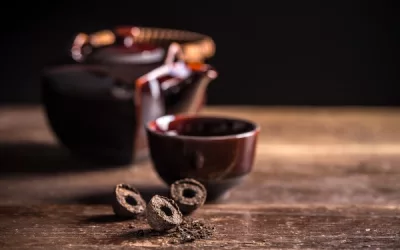Did you know that a simple cup of tea can contain a surprising range of calories, depending on the type and additives? As the popularity of tea continues to soar among health-conscious individuals, understanding its calorie content has never been more vital. This guide will unravel the intricacies of calories in tea, exploring everything from different types to how additives alter their caloric value, while also debunking common myths and providing practical tips for incorporating tea into a weight management plan. Let’s sip our way to clarity!
Table of Content
- What are the calorie counts for different types of tea?
- How do additives affect the calorie count in tea?
- Are there low-calorie tea options available?
- How can tea consumption fit into a weight management plan?
- What are the benefits of drinking tea beyond calorie count?
- What antioxidants are found in tea?
- How does tea aid in hydration?
- Can tea help boost metabolism?
- How do different brewing methods influence tea calories?
- Does brewing time affect the calorie count?
- What brewing temperature is best for preserving low calories?
- How does the type of tea bag or loose leaf affect calories?
- What are common misconceptions about tea and calories?
- How can I track calories in my tea consumption?
- Conclusion
What are the calorie counts for different types of tea?
Tea is a beloved drink around the world and is available in a variety of flavours and types. As someone who watches their calorie intake closely, it can be helpful to know the calorie content of different teas. Whether you enjoy black tea, green tea, white tea, oolong tea, or herbal tea, let’s break down how many calories you’re looking at in each type.
Most plain teas, without any add-ons, are very low in calories. However, the calorie count can change significantly if you add milk, sugar, or honey.
When talking about black tea, for instance, a cup of just the tea itself contains a minimal amount of calories. The same applies to green tea, widely known for its potential health benefits. Herbal teas, which are usually caffeine-free and come in various flavours, also stand out due to their low calorie content.
| Type of Tea | Calories (per 8 oz cup) | Notes |
|---|---|---|
| Black Tea | 2 | Plain, without any additives |
| Green Tea | 2 | Plain, without any additives |
| White Tea | 2 | Plain, without any additives |
| Oolong Tea | 2 | Plain, without any additives |
| Herbal Tea | 0 | Typically calorie-free if no additives |
| Chai Tea (without milk) | 2 | Plain, without milk or sugar |
| Chai Tea (with milk) | 120 | Made with whole milk |
| Matcha Tea | 5 | Plain, without any additives |
| Iced Tea (unsweetened) | 2 | Plain, without any additives |
| Iced Tea (sweetened) | 90 | With sugar added |
| Milk Tea (Bubble Tea) | 250-400 | Varies depending on ingredients and sugar levels |
| Thai Tea | 150-200 | With milk and sugar |
| Tea with Honey | 64 | 1 tablespoon of honey added |
| Tea with Sugar | 16 | 1 teaspoon of sugar added |
| Tea with Lemon | 5 | Plain tea with lemon, no sugar |
| Tea with Milk | 30 | Made with 1 oz of whole milk |
| Sweet Tea | 90 | Typically refers to iced tea with sugar |
How many calories are in a cup of black tea?
A cup of black tea without any additions is incredibly low in calories.
- A standard cup (240 ml) of plain black tea contains roughly 2 calories.
- Adding a teaspoon of sugar increases the calorie count by approximately 16 calories.
- Skimmed milk adds around 5 calories per tablespoon.
- Full-fat milk can add roughly 9 calories per tablespoon.
Drinking black tea in its pure form is almost calorie-free, making it an excellent choice if you’re watching your weight. Just be mindful of what you add to it to avoid unnecessary calories.
What is the calorie count for green tea?
Green tea is praised for its health benefits, from boosting metabolism to providing antioxidants.
- A cup (240 ml) of plain green tea contains about 2 calories.
- Adding a slice of lemon can add around 2 calories.
- A teaspoon of honey adds about 21 calories.
- If you steep green tea with fresh mint, it adds negligible calories.
Similar to black tea, green tea itself is almost calorie-free. It’s the extras like honey or sweeteners that can increase the calorie count, so if you’re aiming to keep it low, enjoy your green tea plain.
Are there any calories in herbal teas?
Herbal teas, which are often made from fruits, flowers, or herbs rather than traditional tea leaves, also boast a low calorie profile.
- A cup (240 ml) of plain herbal tea typically contains 2 calories or less.
- Different flavours or blends may slightly vary but generally stay very low in calories.
- Adding sugar, syrup, or any flavouring will increase the calorie content.
- Many people enjoy herbal teas without any additions due to their natural flavours.
Herbal teas are an excellent option for a flavourful, caffeine-free, and almost calorie-free beverage. The diverse options from chamomile to peppermint ensure there’s a type for everyone without having to worry about calories.
Here’s a little-known fact about tea and its historical influence. During World War II, the British government recognised the importance of tea for morale. Despite shortages, the government ensured a steady supply of tea to British troops and citizens, highlighting its cultural significance. The tea culture remains strong in Britain today, partly owed to its spirit-lifting qualities during tough times.
As someone who enjoys watching their calorie intake, I remember my first foray into learning about calories in drinks. I used to enjoy my tea with sugar and milk until I realised how quickly those extra calories added up. That’s when I switched to plain black and green teas, enjoying them for their pure flavours and almost negligible calorie counts. It was a small change, but it made a big difference in my daily routine and helped me become more mindful of what I consumed.
How do additives affect the calorie count in tea?
When you sip a cup of plain tea, it practically has no calories, fitting perfectly into most dietary plans. But the moment you start adding sweeteners, milk, or cream, the calorie content takes a leap. Let’s delve into how these additives change things up.
Understanding how different additives affect the calorie count in a variety of teas can help you make better informed decisions. Here’s a simple table to guide you through:
Impact of different additives on the calorie content of various teas
| Type of Tea | Additive | Total Calorie Count per Serving |
|---|---|---|
| Black Tea | Plain | 0-2 |
| Black Tea | Sugar (1 tsp) | 16 |
| Black Tea | Milk (30ml) | 15 |
| Green Tea | Plain | 0-2 |
| Green Tea | Honey (1 tsp) | 21 |
| Green Tea | Lemon (1 wedge) | 1 |
| Herbal Tea | Plain | 0-2 |
| Herbal Tea | Agave Syrup (1 tsp) | 21 |
| Herbal Tea | Cream (30ml) | 52 |
| Oolong Tea | Plain | 0-2 |
| Oolong Tea | Maple Syrup (1 tsp) | 17 |
| Oolong Tea | Almond Milk (30ml) | 5 |
This table displays various types of tea, possible additives, and their corresponding calorie counts per serving. Use it to track how different additives affect your favourite brew. It can be surprising how even small additions can change the calorie content significantly.
What are the calorie counts for common tea additives?
Teas alone have minimal calories, but add-ons like sugar and milk bring extra calories. Their impact varies by types and quantity.
- Sugar (1 tsp): Approximately 16 calories
- Honey (1 tsp): Roughly 21 calories
- Milk (30ml): Around 15 calories
- Cream (30ml): About 52 calories
- Agave Syrup (1 tsp): Close to 21 calories
- Maple Syrup (1 tsp): Roughly 17 calories
- Almond Milk (30ml): Around 5 calories
These figures mean each spoonful or dash can make a significant difference. So whenever you brew a cup, think twice before reaching for added sweetness or creaminess.
How can you reduce the number of calories in your tea?
Sticking to basic or natural sweeteners can help keep the calorie count low. Consider these options as you adjust to lighter, healthier tea:
- Opt for no additives or natural flavour enhancers.
- Use a splash of low-calorie milk alternatives like almond or soy milk.
- Skip sugar and choose zero-calorie sweeteners like stevia.
- Add a slice of lemon for a refreshing, calorie-free boost.
By making these small adjustments, you can indulge in your favourite tea without worrying about unwanted calories adding up.
During the Second World War, rationing meant sugar and other luxuries were scarce. Despite this, many British households still enjoyed their daily ‘cuppa’, often sweetened with saccharin, an early artificial sweetener. Saccharin became popular overnight, a testament to how tea drinkers adapt to limitations to maintain their cherished routines. It’s a lesson in how simple choices can maintain traditions while adapting to new circumstances respectfully.

Are there low-calorie tea options available?
Tea lovers, rejoice! If you’re worried about those wicked calories sneaking into your daily cuppa, fret not. There are heaps of low-calorie tea options available. Whether it’s herbal teas, good ol’ green tea, or specific brands shilling low-calorie choices, you’re spoilt for choice, without packing on the pounds.
Now, let’s dive into the tea pool and explore these calorie-conscious options that cater to your health goals.
Which herbal teas are the lowest in calories?
Herbal teas are the darling of low-calorie realms. These delightful brews, sans caffeine, are often so low in calories they could moonlight as water. Here’s a breakdown of some that won’t make your scales shudder:
- Chamomile Tea: The ultimate calming cuppa, packed with antioxidants, and usually zero calories. It’s the zen master of the tea world.
- Peppermint Tea: Fresh and invigorating, this tea aids digestion and intros with zero calories.
- Rooibos Tea: Straight from sunny South Africa, this red tea is naturally sweet and, you guessed it, calorie-free.
- Hibiscus Tea: Vibrant in colour and tangy in taste, this floral brew is another calorie-conscious option, with a mere 2-calorie punch.
- Dandelion Tea: It’s detoxifying and mostly calorie-free. Perfect for those looking to cleanse and revitalise.
Herbal teas offer a vast array of flavours and health benefits without the calorie splurge. From fighting off colds to settling a nervous stomach, these teas pack numerous benefits beyond their near-zero calorie counts.
Can green tea be considered a low-calorie option?
Absolutely, green tea can be considered a brilliant low-calorie option. This ancient elixir, adored since the days of Emperor Shen Nong in China, comes loaded with health benefits and minimal calories:
- Calories: Typically, a cup of green tea contains about 2-3 calories.
- Boosts metabolism: Thanks to its high antioxidant content, green tea is a metabolism-boosting wizard.
- Rich in antioxidants: These little warriors help fend off inflammation and chronic diseases.
- Supports weight loss: Drinking green tea can aid in burning fat, thanks to its thermogenic properties.
- Enhances brain function: The caffeine and amino acid L-theanine combo in green tea support and improve cognitive function.
So, if you’re looking for a tea that not only provides a gentle caffeine kick but also aligns with your caloric caution, green tea is your go-to.
What brands offer low-calorie tea products?
Knowing which brands to browse can save you heaps of time, and possibly, unnecessary calories. Here are some trusted labels that deliver superb low-calorie teas:
- Twinings: A staple in many pantries, this brand has a variety of herbal and green teas with minimal calories.
- Celestial Seasonings: Known for their imaginative herbal blends; Sleepytime and Peppermint are practically zero calories.
- Tazo: Bold flavours with a calorie count that won’t break your diet, ranging from Zen to Wild Sweet Orange.
- Yogi Tea: These teas cater to specific needs – from detoxing to relaxation, all impressively low in calories.
- Bigelow: Offers classic green and herbal teas that are both delicious and diet-friendly.
These brands offer a plethora of low-calorie options, covering every craving from the invigorating to the soothing.
In the bustling streets of 14th-century China, green tea was revered not just as a drink but as a divine prescription. It was in the court of the mighty Ming dynasty that Lu Yu, a tea sage, penned his masterpiece, “The Classic of Tea” – the first definitive work on cultivating, steeping, and drinking tea.
During Emperor Hongwu’s reign, green tea, with its viridescent hue and health-imbued properties, became a symbol of tranquillity and well-being, esteemed by both royalty and common folks alike. To this day, green tea remains a timeless testament to the ancient wisdom of finding balance and purity in simplicity – a nod to the past, yet ever so relevant in our calorie-conscious times.
How can tea consumption fit into a weight management plan?
Let’s dive right in: tea, the beloved beverage, can be your trusty sidekick in your weight management saga. And here’s the lowdown: Yes, tea can actually fit like a glove into your weight management plan. You just need to know how to use it right. Think of it as having a magical wardrobe that transforms your ordinary tea into an extraordinary weight loss elixir. Alright, maybe not that magical, but you get the gist.
First off, let’s debunk the idea that tea alone will make those pounds vanish. True, tea has calories (very few, if you avoid the sugar hitchhiker), but it’s primarily about how it enhances your weight loss arsenal. Now, let’s see how it all fits together.
How much tea should I drink daily for weight management?
Alright, here’s the tea on how much tea you should drink daily to manage your weight. You definitely don’t want to drown yourself in it – moderation is key. Generally, you should aim for about three to four cups of tea daily. This number is enough to keep you hydrated and provide all the benefits without turning you into a living teapot.
- Three to four cups: Keeps the caffeine levels manageable and the benefits maximised.
- Hydration: More tea means better hydration, which can help control hunger pangs.
- Avoid sugar overload: Always steer clear of sugar unless weight gain is what you’re after.
- Green and Herbal teas: They typically have fewer calories, making them a reliable choice for your daily intake.
- Caffeine caution: Too much caffeine can mess with your sleep and mood, which you want to avoid on your weight loss journey.
So, remember – keep it at three to four cups a day to enjoy a healthy, satisfying, and waistline-friendly tea time.
What types of tea are best for weight loss?
Good news folks, not all teas are created equal, but several are ready to be your weight loss allies. When it comes to dropping pounds, your best bets are green tea, oolong tea, black tea, and herbal teas.
- Green Tea: Loaded with antioxidants called catechins, which help boost metabolism.
- Oolong Tea: This gem blends the qualities of both green and black tea, promoting fat burning.
- Black Tea: Rich in polyphenols, it helps with fat oxidation.
- Herbal Teas: Like peppermint or ginger tea, which aid in digestion and reduce bloating.
- White Tea: Prevents the formation of new fat cells, while also boosting lipolysis.
Choose your weapon – or in this case, your teacup – wisely, and let nature’s brew work its magic on your body.
When is the best time to drink tea for weight management?
So, you’ve got your tea selection down and know your limits. Now comes the million-pound (or rather, the million-pound-shedding) question: When should you drink it? Timing can genuinely make a difference.
- Morning: Kickstart your metabolism with a cup of green tea or black tea.
- Before Meals: Drinking tea before meals can help control appetite and prevent overeating.
- Post-Workout: Green tea post-exercise can aid in recovery and boost weight loss benefits.
- Afternoon: A nice herbal tea can fend off those midday munchies.
- Evening: Avoid caffeinated teas before bedtime, but a calming chamomile or mint tea can be perfect for winding down.
Incorporating your tea-drinking wisely throughout the day can make a subtle yet significant difference in your weight management routine.
Back in the 6th century BC, the Chinese Emperor Shennung discovered tea by accident when some tea leaves blew into his pot of boiling water. Legend has it, he found it refreshing and invigorating, which led to the centuries-old tradition of tea in Chinese culture.
Talk about a happy accident, eh? So, next time you sip that cup of green tea, you’re participating in an ancient tradition that has been celebrated for its numerous health benefits for over two millennia. Isn’t it time you brewed that wisdom into your weight management plan?
What are the benefits of drinking tea beyond calorie count?
There’s more to a good cup of tea than just a negligible number of calories. Drinking tea has a host of benefits that go way beyond merely counting calories. Whether you’re into health and wellness or just want to sip on something that’s good for you, tea offers plenty of reasons to keep brewing that pot.
Now, you’re probably wondering, “What can a humble tea bag do for me?” Let’s dig into the juicy bits (or, more accurately, the leafy bits).
What antioxidants are found in tea?
Tea is a powerhouse of antioxidants, those superheroes that fight off the bad guys in our bodies known as free radicals. Different types of tea come packed with various antioxidants:
- Catechins: Mainly found in green tea, these are potent antioxidants that help protect your cells.
- Theaflavins and thearubigins: These little wonders are abundant in black tea, giving it its unique colour and contributing to heart health.
- Polyphenols: Present in both green and black tea, they help combat inflammation. Green tea typically has more.
- Flavonoids: Not only do these compounds help with overall wellbeing, but they also lend green tea its anti-inflammatory properties.
Whether you’re sipping on green, black, oolong or white tea, your body’s getting a solid dose of these protective compounds. Not bad for something so low in calories, eh?
How does tea aid in hydration?
Yes, tea can actually help keep you hydrated. Contrary to popular belief, tea is not a major dehydrator, despite its caffeine content. In fact, for most people, it does quite the opposite:
- Fluid intake: Tea is mostly water. So, every cup you drink contributes to your daily fluid intake.
- Mild diuretic effect: While the caffeine can have a mild diuretic effect, it’s not enough to counter the hydration benefits of the water content.
- Hydration without the sugar: Unlike many other beverages like sodas or even fruit juices, tea gives you hydration benefits devoid of added sugars or artificial nonsense.
Swap out that sugary soda or calorie-laden latte for a cup of tea, and your body will thank you, trust me.
Can tea help boost metabolism?
Ah, the million-dollar question for every fitness enthusiast and weight watcher out there: Can tea rev up your metabolism? Well, the good news is, yes, it can:
- Caffeine content: The caffeine in tea can help increase metabolic rate, albeit modestly.
- EGCG (epigallocatechin gallate): This compound in green tea is known to boost fat burning and metabolic rate.
- Thermogenesis: Certain teas increase the body’s heat production, helping burn off a few extra calories.
- Improved fat oxidation: Some studies suggest that regular tea drinkers have better fat oxidation rates, meaning they use fat more effectively as an energy source.
So, if you’re looking for a tiny metabolic boost, incorporating tea into your daily routine could be your new secret weapon.
Once upon a time, in the Tang Dynasty of China (around A.D. 618-907), tea was not just a beverage but a cherished gift and a symbol of culture. Lu Yu, known as the Sage of Tea, wrote the book “Cha Jing” (The Classic of Tea). He extolled tea as the “elixir of life” and highlighted its various health benefits, from its ability to refresh the mind to its potency as a medicine.
Royals and peasants alike revered tea, not just for its taste but its life-enhancing properties. So, when you sip your tea, remember you’re part of a ritual that has been celebrated for centuries, bringing both health and happiness to those who partake in it. Cheers to that!
How do different brewing methods influence tea calories?
Alright, let’s talk about something more riveting than your aunt’s fruitcake recipe… like tea calories! But seriously, understanding how different brewing methods influence the calorie content of tea can be a game-changer for anyone watching their waistline or just trying to stay healthy. Let’s dive right into it, shall we?
Does brewing time affect the calorie count?
Brewing time does affect the calorie count. But wait, before you freak out and set your timer to the second, let’s break it down a bit:
- Steeping time mainly influences the extraction of flavours and compounds like tannins and antioxidants.
- Longer steeping times might slightly increase the calorie count due to more flavour compounds being extracted.
- However, even with longer brewing times, the calorie difference is negligible. We’re talking a couple of calories at most.
So, while it’s true that steeping your tea for days might squeeze out an extra calorie or two, it’s not worth losing sleep over. Keep it between 3-5 minutes, and you’re golden.
What brewing temperature is best for preserving low calories?
Temperature matters, my friend! If you want to keep those tea calories in check, you’ve gotta nail that perfect brewing temperature:
- Lower temperatures (around 70-80°C) for green and white teas preserve delicate flavours and minimal calorie content.
- Higher temperatures (90-100°C) for black and herbal teas bring out robust flavours, but don’t necessarily add calories.
- Lukewarm or room temperature water can be used for cold brewing, which extracts flavours slowly and might result in fewer calories as well.
So don’t go cranking up your kettle to volcano mode. Keep it chill – or at least not boiling lava hot – for a health-conscious cuppa.
How does the type of tea bag or loose leaf affect calories?
Here’s where it gets interesting – and a bit fancy. The type of tea you use can indeed affect the calorie content. Let’s spill the beans – or the leaves – on this:
- Tea bags often contain smaller, broken tea leaves that might release more solids and potentially add a minuscule amount of calories.
- Loose leaf tea, being purer and less processed, tends to have a slightly better flavour profile and may have fewer calories.
- Herbal mixes in both forms usually contain additional ingredients like dried fruits or nuts, which can contribute to a few extra calories.
- Matcha, a powdered green tea, can have higher calorie content because you’re consuming the whole leaf.
Choose your brewing weapon wisely. Go for loose leaf if you want to be a tea snob with fewer calories, and keep an eye on those herbal blends.
Now that you’ve sipped through the technicalities, here’s a tidbit from history to savour. Did you know that during World War II, the British government considered tea so vital for morale that they included it in soldiers’ ration packs? The morale-boosting beverage was thought to keep spirits high amidst the chaos. So the next time you enjoy your perfectly brewed, calorie-conscious tea, remember: it’s not just a drink; it’s been a symbol of comfort and resilience for centuries. Cheers to that!
What are common misconceptions about tea and calories?
Alright, let’s kick things off with talking about the calories in tea. You’ve probably come across all sorts of myths, half-truths, and straight-up fabrications about the calorie content in your favourite cuppa. Let’s sort through the nonsense, shall we?
First up, the one everyone loves to believe: all tea is calorie-free. Spoiler alert—it’s not. But hey, the situation isn’t as bleak as it sounds. Herbal teas, often free from calorie-dense ingredients, do deliver on the promise for the most part. However, once you start chucking in honey, sugar, or that fancy vanilla syrup, your supposedly innocent cup of tea turns into a deceptive calorie-laden treat.
And then there’s sweetened tea. If you’re thinking you’re sneaking in a healthy drink while sipping on that sugary concoction, think again. Sweetened teas carry more calories than you’d anticipate and may not align with your health goals.
Allow me to clear the fog surrounding these issues.
Is all tea calorie-free?
Let’s set the record straight. Not all tea is calorie-free. While basic black, green, oolong, and white teas are virtually calorie-free, things change when you start adding extras.
- Basic Teas: Black, green, oolong, and white teas have around 2 calories per 8-oz serving.
- Herbal Teas: Often calorie-free but depends on the ingredients.
- Sweeteners: Adding sugar, honey, or syrup can spike the calorie count.
- Specialty Teas: Chai teas or flavoured options may have additional calories due to spices, milk, or additional ingredients.
- Iced Teas: Packaged iced teas often contain added sugars or artificial sweeteners.
And here’s the kicker: those fancy tea lattes and instant teas often have hidden calories from milk powders, creamers, and more. So, if you’re watching your weight, always check the ingredients.
Are herbal teas always low in calories?
Herbal teas often wear the halo of being the healthier, low-calorie option. But is that always true? Not quite. Here’s why:
- Pure Herbal Teas: Root, leaf, or flower-based teas like chamomile or peppermint generally have 0-2 calories.
- Blended with Fruits: Some herbal teas include dried fruits, which can slightly increase the calorie count.
- Sweetened Herbal Teas: Adding honey, sugar, agave nectar, or syrups brings more calories into the mix.
- Packaged Herbal Teas: Ready-to-drink herbal teas may sneak in artificial flavours and sweeteners.
In essence, while the base herbal tea may be virtually calorie-free, the devil’s in the details—what you add to it or how it’s prepared could spike those numbers.
Does sweetened tea still count as a healthy option?
So, you’ve got a sweet tooth and figure adding a little something-something to your tea is no big deal. Is sweetened tea still a healthy option?
- Sugar: A single teaspoon of sugar adds about 16 calories. Multiple that by your desired sweetness, and it can add up quickly.
- Honey: Honey has roughly 21 calories per teaspoon but also carries some nutritional benefits.
- Artificial Sweeteners: These can be low in calories but may have other health concerns.
- Flavoured Syrups: These can add significant calories along with artificial flavours and preservatives.
- Packaged Sweetened Teas: Often contain high-fructose corn syrup, leading to high calorie and sugar content.
Yes, it can still be part of a balanced diet, but moderation is key. If you’re going for a healthy option, try alternatives like stevia or simply enjoy the tea without the added sweetness. This way, you get the full benefit of the antioxidants and other good stuff without the unwanted calories.
Back in the 18th century, tea smuggling was rampant in Britain due to the heavy taxes on tea imports. To curb this, William Pitt the Younger, the then Prime Minister, slashed tea taxes in 1784, effectively eliminating smuggling and making tea accessible to the masses. Interestingly, amidst all this tea drama, people weren’t too bothered about the calorie content. They had different priorities—like avoiding hefty fines and jail time.
How can I track calories in my tea consumption?
When it comes to tracking calories in your tea consumption, there are several effective methods to keep you on top of your game. No, you can’t just eyeball it and hope for the best. Brace yourself because we’re going to dive into the nitty-gritty of calorie tracking using apps, keeping a food diary, and understanding serving sizes.
First things first, keeping track of your tea calories is not rocket science, but you need to be consistent. You wouldn’t want a rogue cup of sugary tea to sabotage all your fitness efforts. So let’s get to the meat and potatoes—or rather, the leaves and water—of the process.
What apps can help track tea calories?
In this digital age, there’s no escaping apps; they are like that one clingy friend who’s (almost) always helpful. Here are a few you can use:
- MyFitnessPal: This app has a ridiculously extensive database. You can easily find calorie information for different types of tea, from green to chamomile.
- Lose It!: Perfect for those who like visuals. Snap a picture of your cup, and it’ll estimate the calories.
- Cronometer: This app is a bit more detailed, allowing you to track micro-nutrients along with calories.
- Nutracheck: Works well for British users, with a straightforward interface for tracking your daily tea consumption.
- Yazio: Known for its simplicity, Yazio helps you log your calorie intake without any fuss.
Using these apps will give you a clearer picture of how much energy (or how little) your tea is contributing to your diet. Just a heads up, if you’re adding any fancy ingredients like honey, sugar, or milk, be sure to include those too.
How do I measure serving sizes for tea?
Serving sizes can be a bit tricky. Are we talking about a tiny tea cup, a mug, or one of those gigantic travel thermoses? Let’s break it down:
- Standard Cup (240 ml): This is what most nutritional information is based on. It’s roughly the size of a regular coffee mug.
- Teaspoons for Sugar: One teaspoon of sugar adds about 16 calories. So, if you’re sweetening your tea, measure it out.
- Milk Additions: A splash of milk can vary, but a tablespoon of whole milk is about 9 calories.
- Tea Bags vs. Loose Leaf: One tea bag per cup, or if you’re using loose leaf, a teaspoon per cup is the norm.
Measuring correctly is crucial because what you think is a “splash” of milk might be closer to a tidal wave. Precision here helps keep everything accurate.
What is the best way to keep a food diary for tea consumption?
Keeping a food diary sounds tedious, but it’s worth its weight in gold—much like a perfect brew of Assam. Here’s how to do it without pulling your hair out:
- Be Consistent: Record every cup. Yes, even the sneaky one you had before bed.
- Note Additives: Make sure you jot down what extras you’re putting in your tea, such as milk, sugar, honey, or lemon.
- Use Apps: Merge your food diary with an app. Most modern apps allow you to jot down notes about each meal or drink you have.
- Daily Totals: At the end of each day, tally up your total tea calorie consumption. It sounds nerdy, but it’s effective.
- Track Patterns: Look back weekly to see if your tea habit aligns with any weight change or health issues.
This method not only keeps you honest but also helps you see patterns, especially if you’re trying to cut down caffeine or sugar.
Back in the 18th century, tea became a huge influence in British society, not just for its flavour but as a social phenomenon. Tea houses became the Starbucks of their time. But funnily enough, even during those times, folks were well aware of the waistline. You’d find that tea-drinkers often had their own little concoctions that didn’t just rely on the tea itself but also embraced an assortment of “add-ins.”
Imagine if King George himself had a calorie-tracking app! I’ll bet he’d have kept a close watch on his sugar lumps. So, whether you drink like a monarch or sip like a commoner, knowing what’s in your comforting cup is as essential today as it was back then.
Conclusion
As I reflect on the vast world of tea and its calorie content, it becomes evident that understanding the calories in tea is crucial for anyone looking to maintain a health-conscious lifestyle. From the natural low-calorie profiles of black, green, and herbal teas to the significant impact that additives can have on overall caloric intake, I’ve emphasised how small choices can lead to substantial differences in our dietary habits.
The importance of being informed about what we consume is not just about numbers; it’s about making empowered decisions that align with our health goals.
Moreover, I’ve highlighted the broader implications of incorporating tea into a weight management plan—navigating through portion control, identifying which teas to favour, and choosing the right moments for consumption can all enhance our overall wellness. The additional benefits of antioxidants and hydration that tea offers only deepen my appreciation for this timeless beverage. By dispelling common misconceptions, we not only clear the air around tea’s caloric value but also appreciate its multifaceted benefits.
I encourage you to take the insights gained from this guide and consider how you can seamlessly integrate tea into your daily routine, making mindful choices along the way. Perhaps try exploring new tea brands that offer low-calorie options or engage with apps that can help you track your intake more effectively. Remember, knowledge is power, and with it, we can make choices that not only nourish our bodies but also elevate our enjoyment of tea.
So, as you sip your next cup, reflect on this: Are you merely consuming tea, or are you embracing the experience and health benefits it offers? After all, in a world where we often count calories, sometimes it’s time to count the moments of joy that a simple cup can bring.
Resources
- Antioxidant mechanism of tea polyphenols and its impact on health benefits
- Molecular mechanisms underlying health benefits of tea compounds
- Antioxidant Effects of Tea: Evidence from Human Clinical Trials
- Green tea for weight loss and weight maintenance in overweight or obese individuals
- Black tea–helpful or harmful? A review of the evidence
- Drinking black tea linked to longevity







